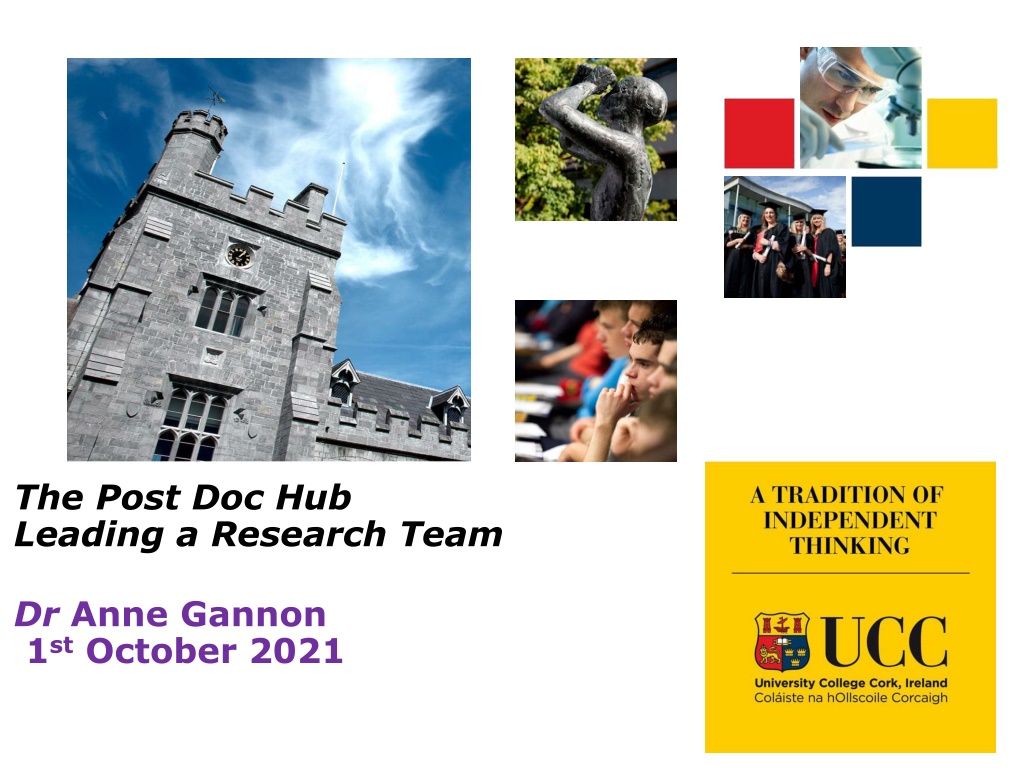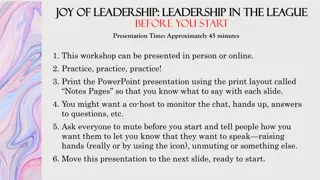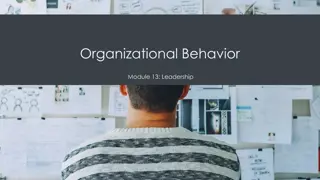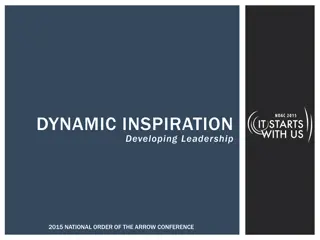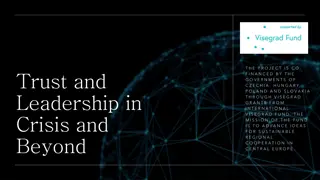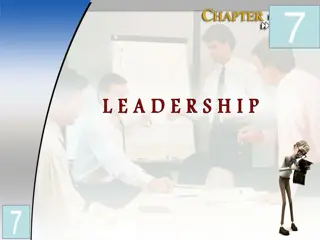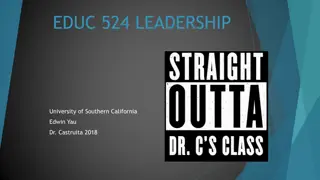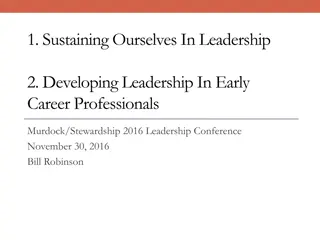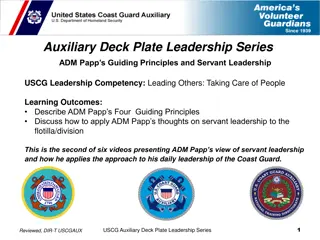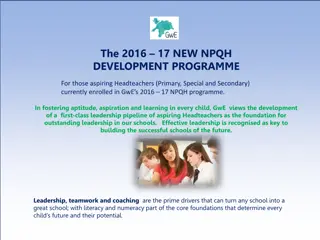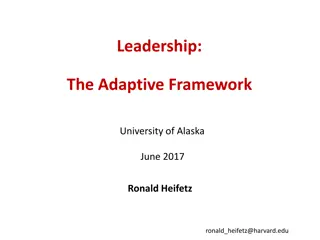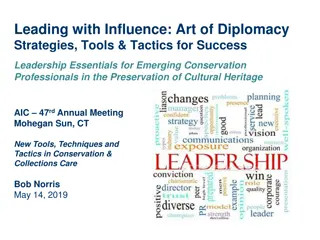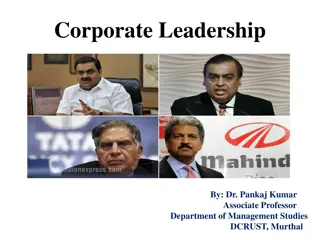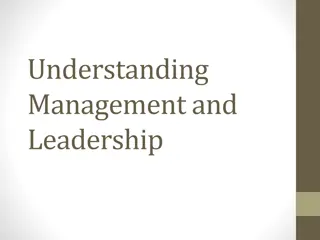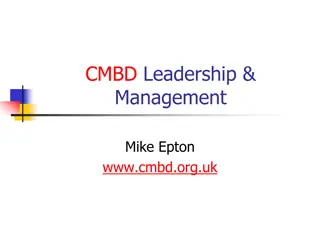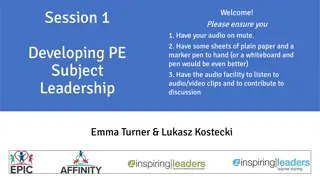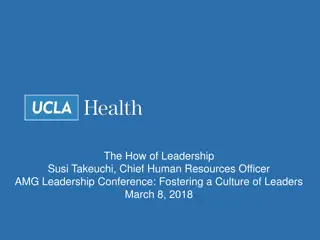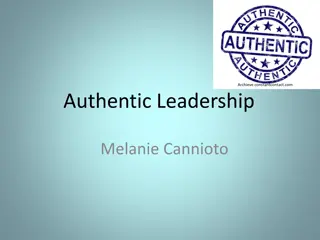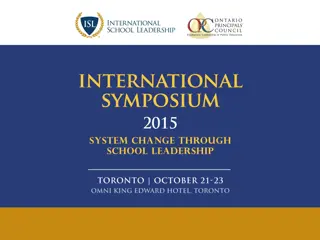Exploring Effective Leadership Practices and Strategies
This presentation delves into the essence of leadership, emphasizing its role in influencing and guiding collective efforts towards achieving goals. It outlines the qualities that make a leader effective, highlighting the importance of both hard and soft skills. By examining real-world examples and insights, the session aims to enhance participants' understanding of leadership and empower them to refine their own leadership styles and approaches.
Download Presentation

Please find below an Image/Link to download the presentation.
The content on the website is provided AS IS for your information and personal use only. It may not be sold, licensed, or shared on other websites without obtaining consent from the author. Download presentation by click this link. If you encounter any issues during the download, it is possible that the publisher has removed the file from their server.
E N D
Presentation Transcript
The Post Doc Hub Leading a Research Team Dr Anne Gannon 1stOctober 2021
Session Objectives To explore what leadership is To identify what make leaders effective To reflect and develop some insight into enhancing your own leadership style and approach To consider and plan for your ongoing leadership development
What is Leadership? Leadership is a process of social influence, which maximises the efforts of others, towards achievement of a goal (Kruse, K.2013) Leadership is the ability to influence others, with or without authority (DeLisle,P. 2019) Leadership is a process of giving purpose (meaningful direction) to collective effort, and causing willing effort to be expended to achieve purpose. (Jacobs & Jaques, 1990)
The Practice of Leadership From working with and observing leaders in action, what is effective leadership from your own experiences? Consider What makes a leader effective? What do effective leaders do and how do they do it? What do others look for in a leader?
Leading by example 85% of job success comes from having well-developed soft skills & people skills. 15% of job success comes from technical skills & knowledge (hard skills) (Harvard University, the Carnegie Foundation & Stanford Research Centre)
What is Leadership? the accomplishment of a goal through the direction of human assistants. The leader may not possess or display power; force or the threat of harm may never enter into their dealings They may not be popular- nor a colourful person; Their unique achievement is a human and social one which stems from his understanding of his fellow workers and the relationship of their individual goals to the group goal (E.C.H Prentice, HBR, 2004)
What is leadership? Leadership it starts with you. (P.Drucker) Leadership is about who you are Leadership is about how you act Leadership is about what you do Leadership is about how you work with others (Kotter, 2012)
Emotional Intelligence (EQi) and Leadership Emotional intelligence is defined as the ability to understand and manage your own emotions, as well as recognise and influence the emotions of those around you. More than a decade ago, Daniel Goleman highlighted the importance of emotional intelligence in leadership, The most effective leaders are all alike in one crucial way: They all have a high degree of what has come to be known as emotional intelligence. It s not that IQ and technical skills are irrelevant. They do matter, but...they are the entry-level requirements for executive positions.
What is emotional intelligence? 5 Elements comprising Self-awareness. Self-regulation. Motivation. Empathy. Social skills. (Daniel Goleman, 2009)
Leadership Styles In Practice Modus operandi of the leader Style in a Phrase Underlying EI Competencies When this style works best DIRECTIVE / COERCIVE Demands immediate compliance Do what I tell you, now! Drive to achieve, initiative , self- control In a crisis, to kick start a turnaround, or with a problem AUTHORITATIVE / VISIONARY Mobilises people toward a vision Come with me. Self-confidence, empathy, change catalyst When changes require a new vision, or when a clear direction is needed. AFFILIATIVE Creates harmony and builds emotional bonds People come first Empathy, building relationships, communication To heal rifts in a team, motivate people during stressful times.
Leadership Styles In Practice Leadership Style Modus operandi of the leader Style in a Phrase Underlying EI Competencies When this style works best PARTICIPATIVE / DEMOCRATIC / COLLABORATIVE Forges consensus through participation What do you think? Collaboration, team leadership, communication To build buy-in or consensus, to get input from valued employees PACE-SETTING Sets high standards for performance Do as I do. Conscientiousness, drive to achieve, competent team To get quick results from a highly- motivated and competent team. COACHING Develops people for the future Try this Developing others, empathy, self- awareness To help an employee improve performance or develop long-term strengths
Learnings about Leadership and EQi When the leader succeeds, it will be because they have learned two basic lessons: people are complex, and people are different. (W.C.H Prentice, HBR, 2004) There are pros and cons to every style Remember, regardless of your role - it takes two to tango! seek to be both respectful and adaptable It is your responsibility to consider how your style can impact others and work actively to develop an environment which is conductive to good morale
What do followers look for in their leaders? Authenticity Followers want leaders who are extremely good at what they do, but who have not lost sight of where they have come from, or who they are. Significance Followers tend to respond to leaders who make them feel like their contributions matter. Community Followers also look for their leaders to create a sense of common purpose at work, and a desire within the group to relate and interact with each other. Excitement What followers really want is to get a buzz and feeling of excitement from their leader. Goffee and Jones, 'The Art of Followership', European Business Forum (Summer 2006), p 24.
The 3 Cs of Remote Leadership (Wingard, J. Forbes, 2020) Clarity around goals, roles, expectations, boundaries and communication Communication without micro-managing Connection create and maintain trust and engagement
How to actively develop your leadership skills Reflect and identify the skills that you need to lead effectively and create an action plan to develop these Ask for feedback from work colleagues and your manager Take opportunities to lead in work, volunteering etc. and reflect and learn from this experience Take ownership for your own training and development
Session Learning What will you do differently as a result of attending this webinar?
